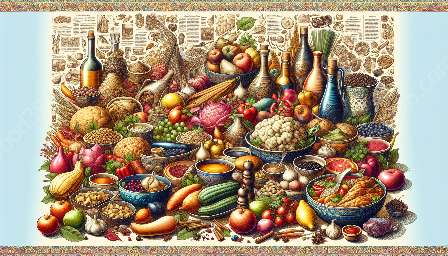Early agricultural tools and technologies played a crucial role in the development of food cultures and the evolution of food culture. Ancient civilizations utilized various innovative methods and implements to cultivate the land, enhance crop yields, and sustain their populations. This topic cluster delves into some examples of early agricultural tools and technologies, their significance, and their influence on the origin and evolution of food culture.
1. The Plow
The invention of the plow revolutionized early agricultural practices. Ancient civilizations, such as the Mesopotamians, Egyptians, and Romans, utilized different types of plows made from wood or iron. The plow facilitated the process of tilling and preparing the soil for planting, leading to increased efficiency and productivity in farming. Its introduction marked a significant leap in the development of food cultures.
2. Irrigation Systems
Ancient civilizations devised sophisticated irrigation systems to manage water resources and promote agricultural growth. The Sumerians in Mesopotamia constructed canals and dikes to control the flow of water, enabling the cultivation of crops in arid regions. Similarly, the Indus Valley Civilization implemented intricate systems of canal networks for irrigation, laying the foundation for sustainable food production and fostering a unique food culture.
3. Agricultural Tools
Ancient agricultural societies crafted a myriad of tools, including sickles, hoes, and threshing implements, to streamline farming activities. The development of these tools enabled efficient harvesting, processing, and storage of crops, contributing to the diversification and evolution of food cultures across different regions.
4. Crop Rotation
Ancient agricultural practices also incorporated innovative techniques such as crop rotation. Civilizations like the ancient Greeks and Romans implemented crop rotation to replenish soil nutrients and prevent depletion, elevating agricultural productivity and shaping the types of crops cultivated, thus influencing food cultures and dietary preferences.
5. Food Processing Technologies
Early civilizations developed various food processing techniques to preserve and enhance the nutritional value of harvested crops. These included methods such as drying, fermenting, and milling, which contributed to the creation of diverse food products and culinary traditions. The utilization of such technologies laid the groundwork for the development of distinct food cultures around the world.
6. Domestication of Plants and Animals
The domestication of plants and animals marked a pivotal advancement in early agricultural practices. Civilizations such as the ancient Chinese and Mesoamerican societies selectively bred and cultivated crops and livestock, leading to the establishment of agricultural economies and the emergence of food cultures based on specific agricultural products and culinary traditions.
7. Storage Facilities
Ancient civilizations constructed various storage facilities, such as granaries and silos, to store surplus crops for future consumption. These facilities played a crucial role in food preservation and distribution, contributing to the establishment of trade networks and the diffusion of food cultures across different territories.
The Impact of Early Agricultural Tools and Technologies
The adoption of early agricultural tools and technologies by ancient civilizations significantly influenced the development of food cultures. These innovations not only facilitated increased food production and security but also led to the diversification of agricultural practices, the expansion of trade networks, and the exchange of culinary knowledge and food traditions. The utilization of advanced agricultural implements and techniques laid the foundation for the unique food cultures that continue to shape culinary practices and dietary habits today.
Conclusion
The utilization of early agricultural tools and technologies by ancient civilizations played a pivotal role in shaping the development and evolution of food cultures. The innovations in farming methods, irrigation systems, food processing technologies, and the domestication of plants and animals were instrumental in shaping the diverse food cultures that have enriched global culinary heritage. Understanding the impact of these early agricultural practices and technologies provides valuable insights into the origins and evolution of food culture across different civilizations and regions.


